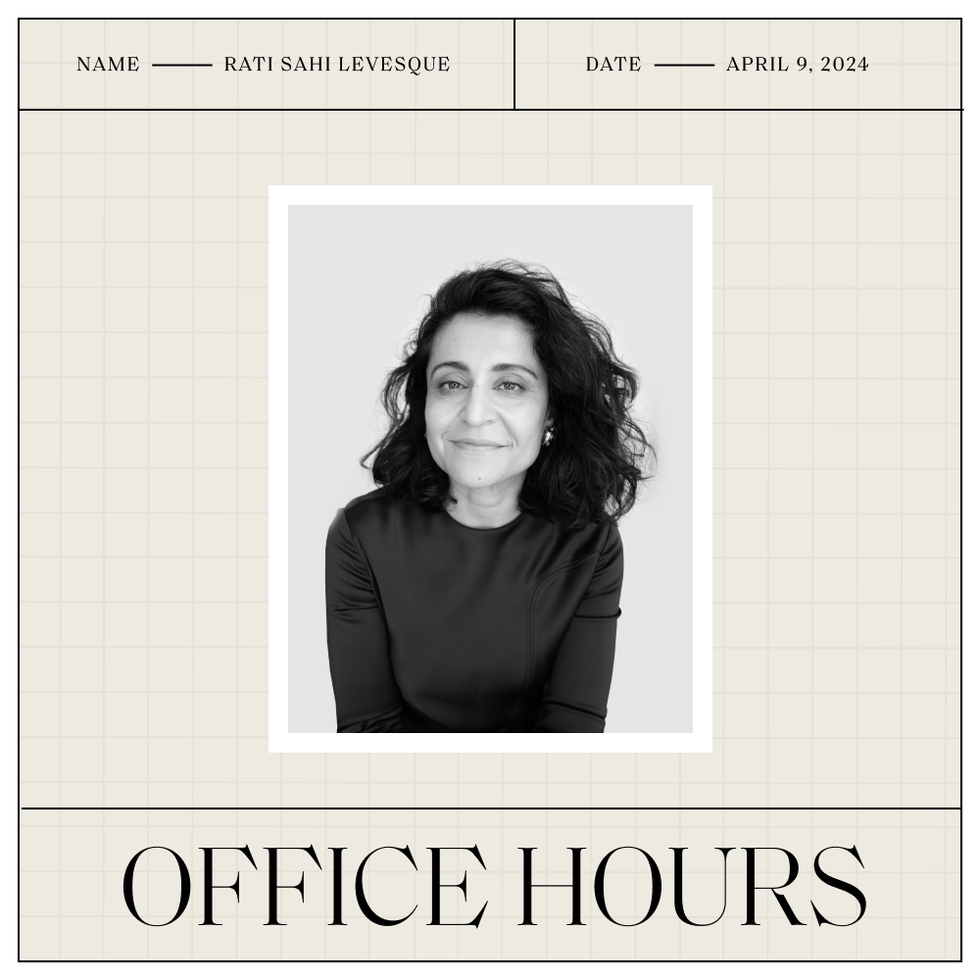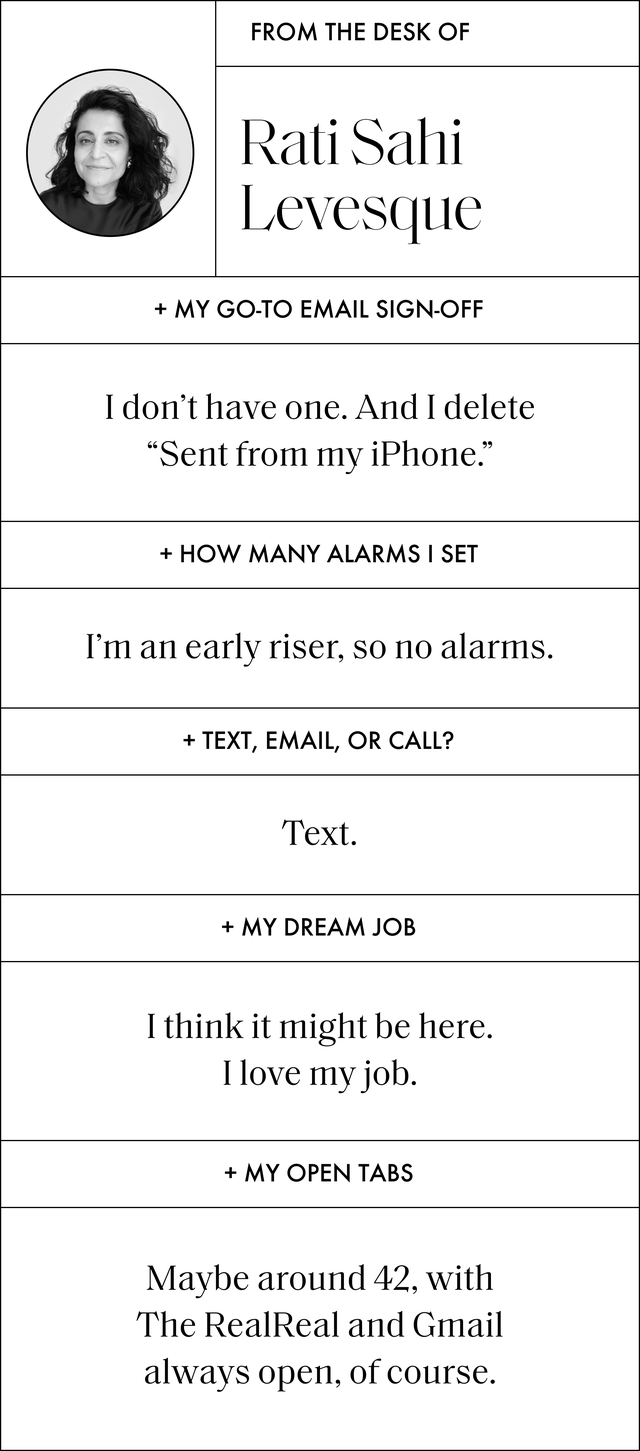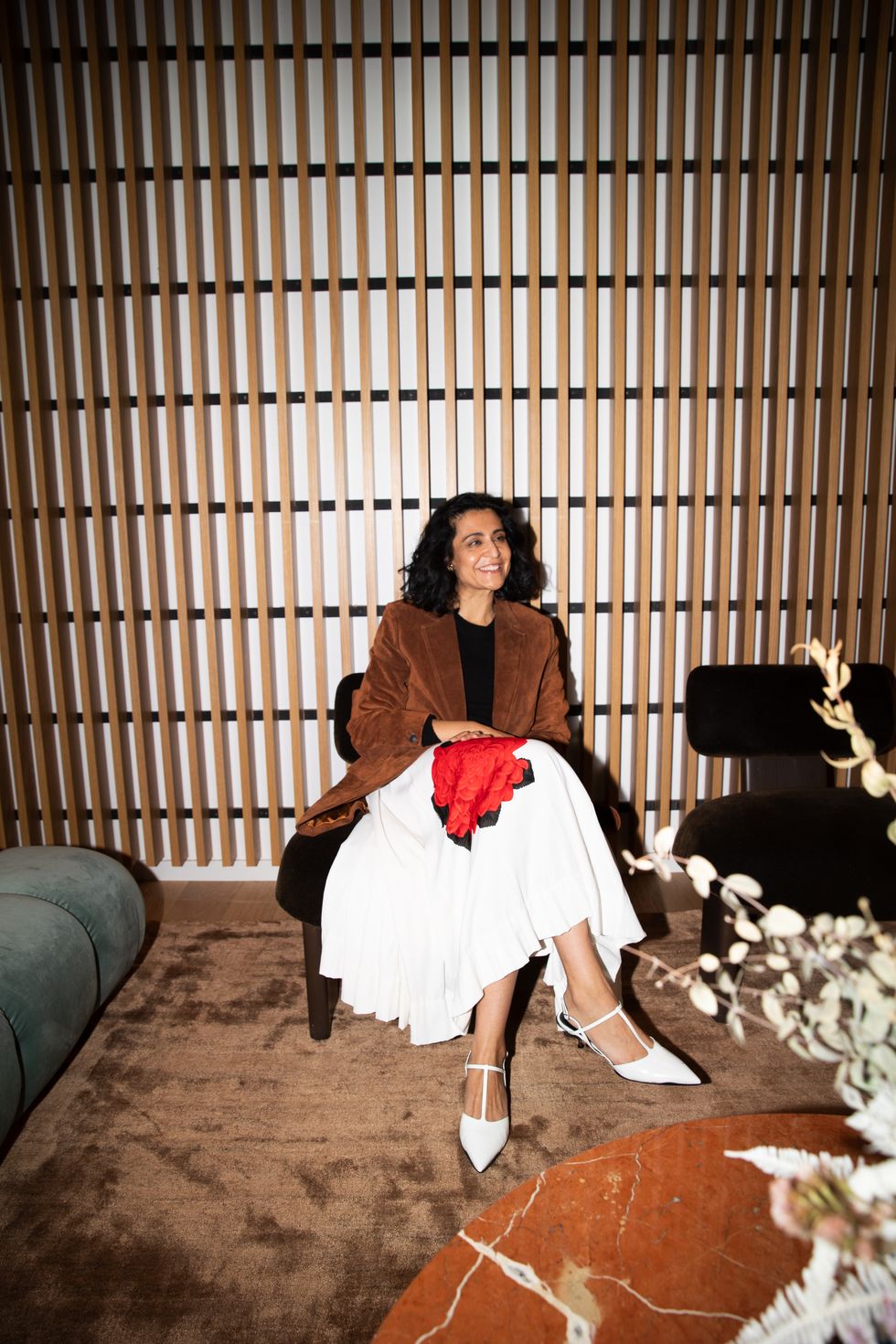Products You May Like
In ELLE.com’s monthly series Office Hours, we ask people in powerful positions to take us through their first jobs, worst jobs, and everything in between. This month, we spoke with Rati Sahi Levesque, the president and chief operating officer of The RealReal, the trailblazing e-tail source for secondhand, luxury shopping. Along with founder Julie Wainwright, Levesque faced the kinds of challenges you might expect when bringing a previously gatekept consignment experience to the internet—but she also reaped the rewards. Now, The RealReal is at the forefront of changing consumer attitudes about the life cycle of a product, something Levesque has strived for ever since she closed her own San Francisco consignment shop in 2011 to start the company. Below, Levesque takes us through her career journey, from her small store to a worldwide network of shoppers and sellers, and shares just a few of the lessons she’s learned along the way. One of which? Don’t bother with an email sign-off.
My first job
It was for an escrow company. I was a secretary—then, they called them secretaries. I was the person at the front desk.
My worst job
That might’ve been it. It wasn’t a very exciting office, as far as it was on the fourth floor of a very carpeted, very gray building. There was a lot of stress oozing from those people. They were just very strange. There was a lot of yelling going on. Oh my God, now I’m really going back to that time. [Because of that experience,] I know how not to treat 22-year-olds in their first job.
Why we started The RealReal
I had a consignment store in Russian Hill in San Francisco. It was online and at a physical location. I would go to the Goodwill and other consignment shops and find vintage designer items and sell them in my store, but it was tough to make ends meet, and my rent was very expensive. I met Julie through a mutual friend, and then we decided to go do this. I realized how much people gravitated toward consignment and how there was no one in the e-commerce space or online that was doing it. There were consignment shops, which were great, but there was no transparency in the experience or pricing—and you’d bring in all these clothes, and you get rejected in front of a huge line of people. It just seemed very transactional. I didn’t think they were appreciating these pieces that I was consigning—the ’90s Chloé shorts that I saved all my money to buy, or whatever it was. That’s how we got started. We took that list from the store that I had and Julie’s contacts and just started cold-calling everyone to collect consignment early on.
The wildest moment from those early days
The time we got our first Birkin confirmed, I felt like we made it. This was the first few weeks that we started the company. We just sent out a direct mail piece to certain zip codes, and someone replied back and sent us a Birkin. That was a turning point for me, because it was like, this thing’s going to work, this thing has legs.
Learning from our missteps over the years
We made so many mistakes, so many things we would do differently. We tested a lot of things that didn’t work. At some point, we opened flagship stores that cost a lot of money and were too big to run. We realized that they took too much capital, and they didn’t make sense. Then we moved to these neighborhood stores. I’d say, every month, we were learning something big in that way. During COVID, we started buying product. We lost our compass for a second. We were buying inventory, because we couldn’t get into people’s homes to consign. That set us back in profitability in a big way. It took us a second to re-engage. We really had to zoom out for a second and say, “Okay, we made all these decisions, and we’re in this place, but now, we have to unravel, and we have to figure out how to get back to our core.” That took some time—18 months—to get to where we are now.
How we’re transitioning people away from fast fashion
I heard this statistic early on that 2,000 items are thrown away every second. That’s what made me get into consignment for my small store in San Francisco. We want to change behavior and make sure people understand that clothing is not meant to be thrown away, but instead altered or repaired. My mom always repaired our clothes growing up, whether it was a sock or whatever. You just didn’t throw things away. Our job is to educate people on resale, because 50 percent of consigners have never consigned before. We really are having to teach people about what holds its resale value and what doesn’t, so they’re empowered to make better shopping decisions. As we do our awareness studies every year—we take more of a macro view of our consumer base—one of the stats I’m really proud of is that we are replacing fast fashion. So instead of buying fast fashion, consumers are thinking about The RealReal, because they can buy and then resell an item. It’s totally different.
Why secondhand shopping requires confidence
Now it’s a badge of honor to have something that’s one-of-a-kind and to wear it and make it feel modern again. It’s about your style and your self-expression. It’s really cool. I always say that to shop resale or vintage or consignment, there is a certain confidence that you need, right? Because you are taking an item, and you’re making it new, and you’re making it unique. It’s not something that everyone has, and maybe you don’t know what to wear it with right away. It takes some playfulness. We’re almost 70 percent female [at the company], and I see a lot of 22-year-old girls, and this is their first job or internship, and they’re starting to find that sense of style. They’re able to experiment, because we do make it accessible. It’s fun to watch.
On gaining the trust of luxury brands
We are the stewards of authentication. No company does more than we do to keep fakes off of the market. And we’ve made some progress. We’ve had partnerships with Stella McCartney— she was the first, honestly, and really paved the way for a lot of the luxury brands—and after that, Burberry, Jimmy Choo, Gucci, they all followed. I think they’re starting to see— and our data is showing—that when people consign, let’s say, a Gucci bag from last season, they take that money and then buy the Gucci bag from the following season. So we’re not necessarily cannibalizing or taking their business. They’re starting to see that life cycle of luxury and that shift in their consumer behavior. There are always going to be some brands that will never get there but a lot more are starting to catch on.
How I feel about brands creating their own resale platforms
I think that’s great. More awareness and more people thinking about it is awesome. I always advocate for that. When we think about sustainability, and we think about our mission, it’s bigger than TRR. I do find that people like having the one-stop shop, and that’s one of the services that we offer. And people like cash versus a site credit. Those things help us continue to be the leader in this space.
The advice I’d give my younger self
Don’t sweat the small things. Early on in your career, everything is a big deal. As an entrepreneur, all that anxiety helps drive you and moves you forward. But that’s the best advice. Honestly, there are a lot of people out there who are smarter than you, better than you. It’s just about good old-fashioned hard work. That’s the main thing that makes people stand out versus others. It’s not rocket science at the end of the day.
My best The RealReal shopping hack
One of the things I love to do is go to the Editors’ Picks. Every morning, I wake up, and I check my email, of course, then I go to New Arrivals on The RealReal and then the Editors’ Picks. Our editors have great taste, and it’s nicely curated for me.
This interview has been edited and condensed.




